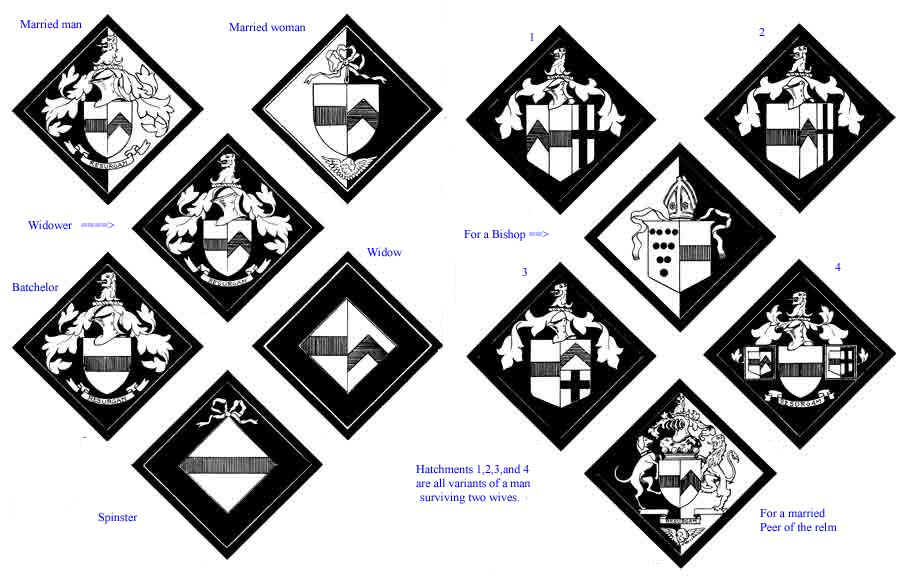Sinister background black
Sable a fess wavy between two estoiles of six points argent a molet or for difference, the
Badge of
Ulster (Drake), impaling, Vert a chevron ermine between three griffins’ heads erased
or (Berindon)
Motto: Sic parvis magna
Two cherubs’ heads above shield
Now identified as Sarah Gardner, who married as his 1st wife,
Sir Francis
Samuel Drake, 1st and last Bt., and died 3 Feb 1786 aged 57; buried as "Lady Sara
Drake" 12 Feb
1786.
(B.E.B.; Drake biography; P.R.; M.I. in churchyard; Bank of England Will Extract Bk 6
No.2984)
(This hatchment, when recorded in 1955, was in poor condition; when checked in 1975 and
2003 it
was almost indecipherable) |
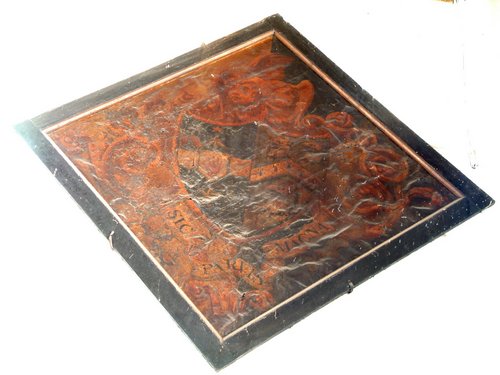 |
All brown background
Or a chevron sable between three ducks sable, beaked and legged gules (Steyn of Harlem)
Crest (on a barred affronté helm): A duck as in the arms rising
(D'or au chevron de sable accompagné de trois canettes du même becquées et membrées de
gules.
Cimier: Une canette de l'écu essorante)
Mantling: Sable and or
A small hatchment in Dutch style, with a wide frame inscribed Obit XX Martii at top and
Anno
MDCLXXXXVI at base, and a narrow eave on the upper edges of the frame.
For Matheus Steijn of Haarlem, Navy of the United Netherlands, who commanded the Damiaten
at
Brest in 1694, was Captain of the (64-gun) Amsterdam in 1696, died 10 Mar 1695/6
(Gregorian 20
Mar 1696) and was buried at Deal 13 Mar 1695/6.
(P.R., Rietstap; de Jonge) |
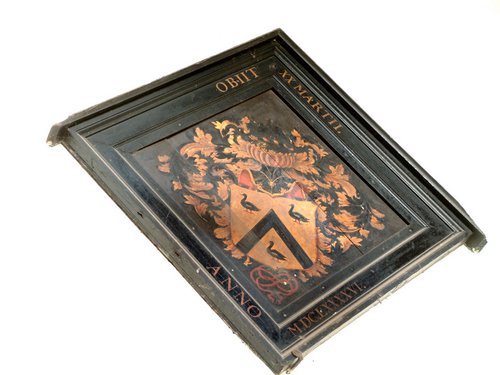 |
All black background
Azure a chevron ermine between three griffins’ heads erased argent langued gules
(Gardner)
Crest: A griffin sejant argent langued gules, resting its dexter claw on a book sable
garnished or
Mantling: Gules and argent
Winged skull in base
A small hatchment, c. 2 ft. x 2 ft. excluding the wide gold and black frame
For Captain Thomas Gardner, buried 2 Jul 1699;
(P.R.) |
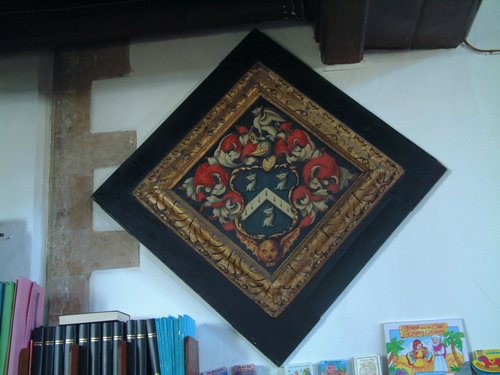 |
Sinister background black
Sable ermined or a griffin segreant argent, legged, armed and langued or (Baker) In
pretence: Azure
latticed argent a lion rampant or (for Bromshall)
Crest: From a naval coronet or a cubit mailed arm or holding a trident fessways sable
headed argent
Mantling: Gules and argent
Motto: Manet post funera virtus
For Elizabeth Bromshall of St Mary Dover, who married 1767 John Baker of Deal, and was
buried 5 Jan
1799
(P.R., Canterbury Mar. Lics.) |
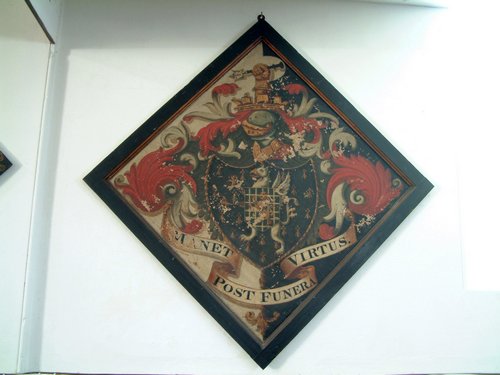 |
All black background
Azure a chevron argent between three standing bowls or, issuing therefrom three
boars’ heads
palewise argent tusked or langued gules (Bowles)
To dexter of main shield, Sable three pheons argent (Nicholls), impaling, Bowles Dexter
background
black
To sinister of main shield, Argent a lion rampant within a bordure azure (Renton),
impaling, Bowles
Dexter background black
No crest
Mantling: Gules and argent
On motto scroll: In Memory of Mrs. Thomasin Renton
Frame decorated with skulls and crossbones
For Thomasin Bowles, who married 1st, George Nichols of Deal, and 2nd, 1710, Alexander
Renton
(died 1720), and died 1730
Thomasine Rentone bur 1 May 1730
(Mar. Lic., P.R.; PCC Will) |
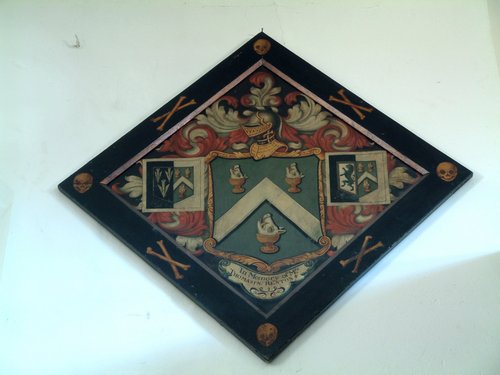 |
All brown background
Sable three chevronels ermine (Wise)
Crest: A demi-lion argent holding in the dexter paw a mace erect or
Mantling: Gules and argent
On motto scroll: In Memory of Mr. Sampson Wise
A small hatchment, c. 2 ft. x 2 ft., including frame
For Sampson Wise, who died 1673/4
Mr Samson Wise gent. bur 26 Jan 1673/4
(P.R.) |
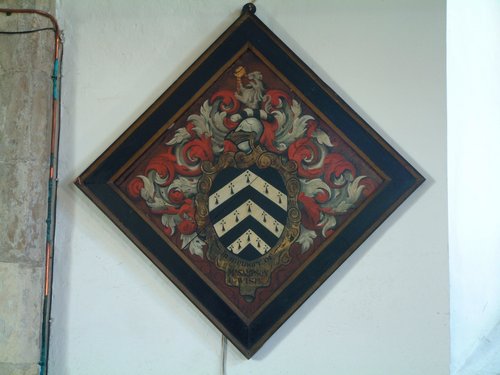 |
All black background
Argent a saltire gules a label sable for difference (Gerard)
Crest: A monkey passant sable langued gules, collared and chained at the waist or
Mantling: Gules and argent
On motto scroll: In memory of Mr. Henry Gerard who departed this life the 27th of
September A° Dom.
1698 In ye 24th Yeare of his age’
Wide black frame decorated with skulls, crossbones and monogram of HG
Hy. Gerard bur 1 Oct 1698
(P.R.) |
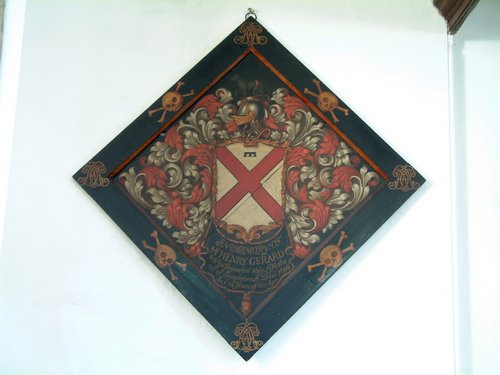 |
All black background
Sable ermined argent a griffin segreant or (Baker) In pretence: Chequy azure and or a lion
rampant
argent armed and langued gules (for Bromshall )
Crest: As 2, but arm sable and trident gules headed or
Mantling: Gules and argent
Motto: In coelo quies
For John Baker of Deal, esq., who was buried 22 Jul 1802
(P.R.; PCC Wills)
John Baker's daughter Sophia's hatchment is at Narborough, Norfolk; that of the husband of
his
daughter Elizabeth Honora is at Walmer |
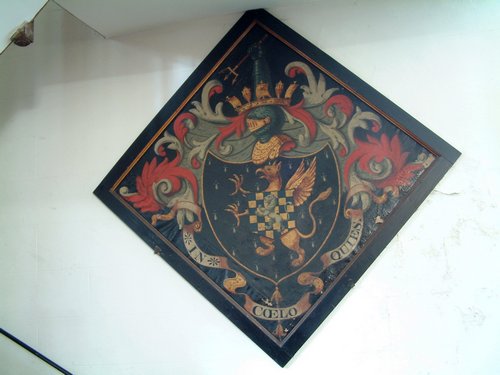 |
All brown background
Gules a chevron between three molets or (Poulton)
Crest: A lion’s head erased affronté sable ducally gorged or
Mantling: Gules and argent
Frame decorated with skull and crossbones, and inscribed ‘In Memory of Capt. Tho:
Poulton’ and at top
and base 16 and 99
For Capt. Thomas Poulton, who died 1699.
Ct. Thos. Poulton bur 22 Jun 1699, Str[anger]
(P.R.) |
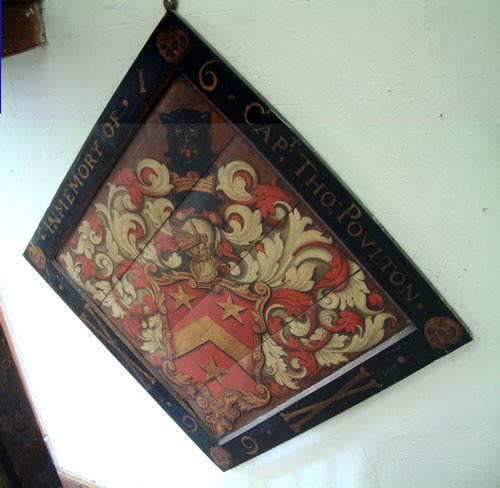 |
All brown background
Per chevron argent and sable in chief two fleurs-de-lys and in base a tower or (Serocold)
Crest: A tower or surmounted by a fleur-de-lys argent
Mantling: Gules and argent
Frame decorated with skulls and crossbones and date 1705
Probably for George Serocold, buried at Deal, 23 Jan. 1705/6.
Geo Sarocold Gent., bur 23 Jan 1705/6
(Archaeologia Cantiana, P.R.) |
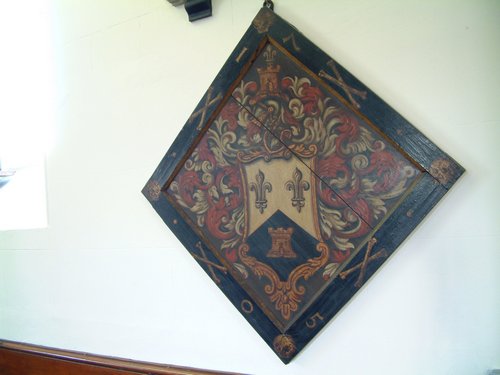 |
All black background
Argent a saltire gules a crescent sable for difference (Gerard)
Crest: A monkey passant sable collared at the waist and chained or
Mantling: Gules and argent
On motto scroll: ‘In memory of Mr. Henry Gerard late Rector of this Parish who
departed this life the
2nd day of January in the 65th year of his age, Anno Dom. 1710’.
Frame decorated with skulls, crossbones and hourglasses |
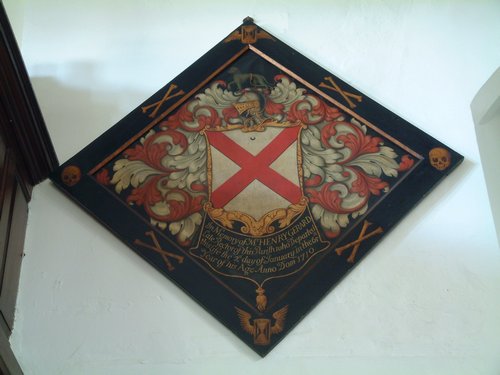 |
All black background
Argent gutty gules a lion rampant sable crowned or (Scriven)
Helm, but no crest
Mantling: Gules and argent
On scroll in position of crest: ‘In Memory of Mris Mary Screven who died ye 18th of
lune 1687 in ye
18th year of her age’
Frame decorated with skulls and crossbones A small hatchment c. 2 ft. 6 ins. x 2 ft. 6
ins.
Mrs. My. Screven bur 20 Jun 1687
(P.R.) |
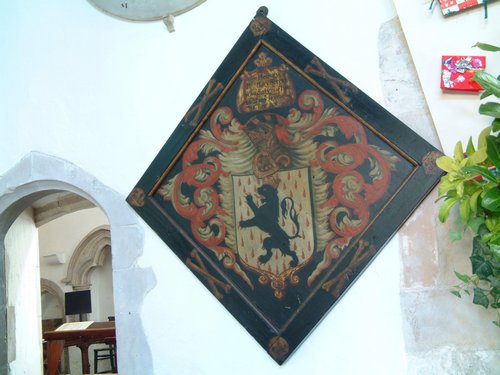 |
Dexter background black (not All black background)
Drake, as 15, impaling, Argent a fess gules between six choughs sable (Onslow)
Crest: A sailing ship or, on a terrestrial globe, drawn by golden hawsers, from a hand
proper the arm
habited gules cuffed argent issuing from clouds proper
Mottoes: (above crest) Auxilio divino (below shield) Sic parvis magna
Mantling: Gules and argent
For Sir Francis Samuel Drake, 1st and last Bt., who married 2nd, 23 Jan 1788, Pooley
Onslow, daughter of George Onslow, M.P. for Guildford, and died s.p. 18 Nov 1789 aged 61;
she married 2nd,
13 May 1801, Arthur Onslow, serjeant-at-law, and died 10 Dec 1810. Her hatchment may be
Send SRY
no.2.
(B.E.B.; B.P. 1911 ed.; M.I. in churchyard) |
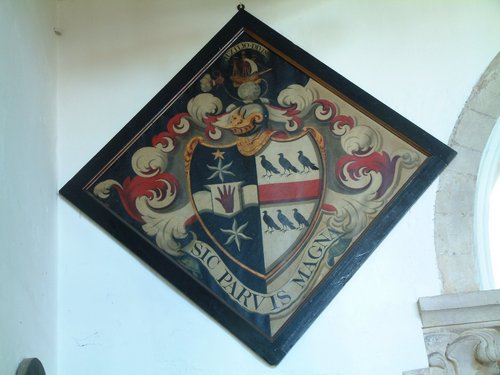 |
All black background
Two oval shields
Dexter, within the Order of the Bath and with star pendent below, Harvey, with a molet
argent on a
molet sable for difference
Sinister, within an ornamental wreath, as dexter, impaling, a blank
Crest, mantling and motto: As 13.
Supporters: Two sailors proper in their exterior hands a staff with a flag argent charged
with a cross
gules, in the dexter canton an anchor azure
For Admiral Sir Edward Harvey, G.C.B., who married Eliza Ann (died 23 Aug. 1857), only
daughter of
John Cannon, and died 4 May 1865.
(M.I.) |
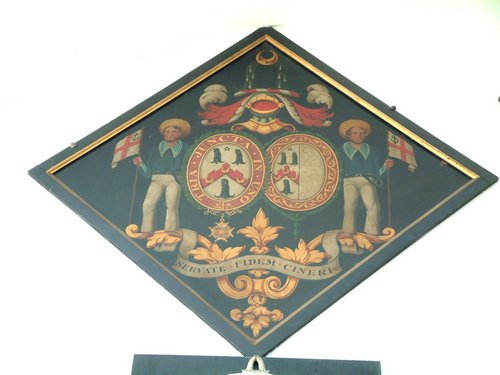 |
All black background
Or a lion rampant gules within a bordure engrailed sable (Pomeroy), impaling, Argent three
roundels
and a chief gules (Beesley)
Crest: A demi-lion gules in its dexter paw a bezant
Mantling: Gules and argent
On broad scroll below shield: ‘Here lieth the body of Capt. George Pomeroy, son of
Capt. Wm Pomeroy
of the West late Commander of their Majesties Ship the Rupert who received his mortal
wound against
the French off Beachy and departed this life the 25th day of July 1690 in ye 39th year of
his age
leaveing his wife and 3 children behind him.’
Frame decorated with skull and crossbones |
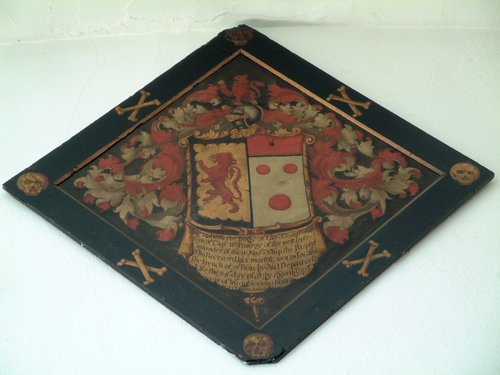 |
Dexter background black
Two oval shields
Dexter, within the Order of the Bath, Argent on a chevron embattled gules between three
bears’
gambs erect erased sable ermined argent three crescents or ermined sable (Harvey)
Sinister, Harvey, impaling, Gules a chevron between three boars’ heads couped or
(Bradley)
Crest: Two bears’ gambs erect erased sable ermined argent holding a crescent or
ermined sable
Mantling: Gules and argent
Motto: Servate fidem cineri
For Admiral Sir John Harvey, K.C.B., Admiral of the Blue, who married 1797, Elizabeth,
daughter of
William Wyborn Bradley, of Sandwich, and died 17 Feb. 1837.
(M.I.)
(This hatchment, when recorded in 1955, was in poor condition; when checked in 1975 and
2003 it
was almost indecipherable) |
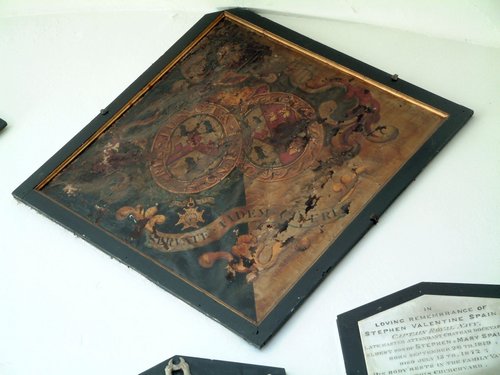 |

